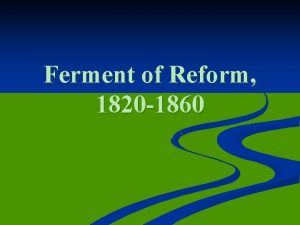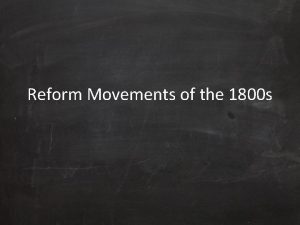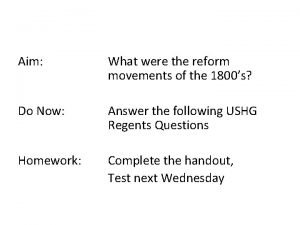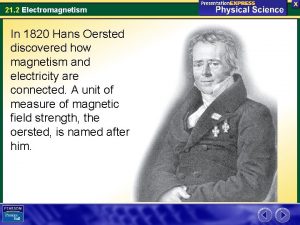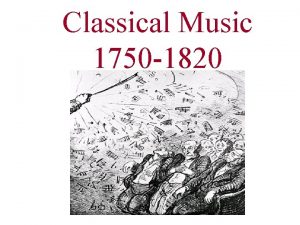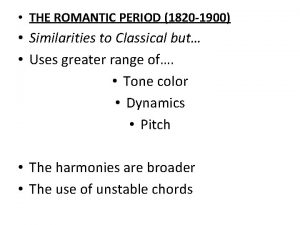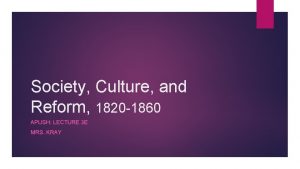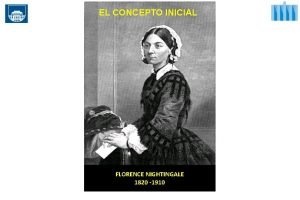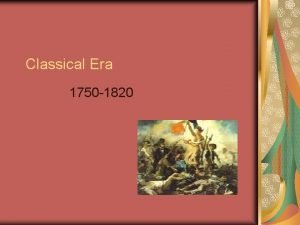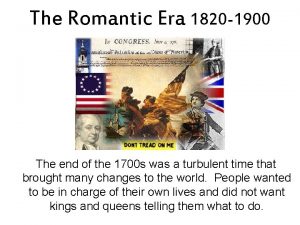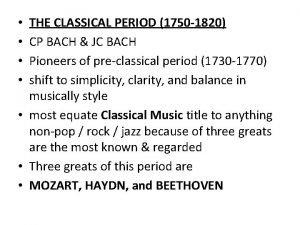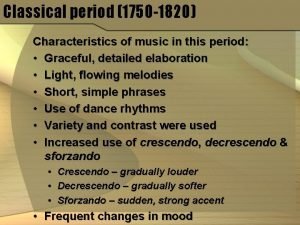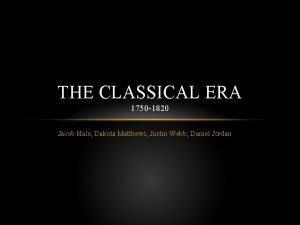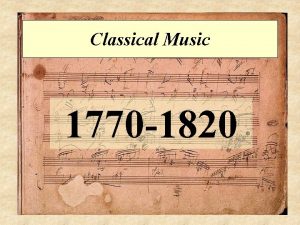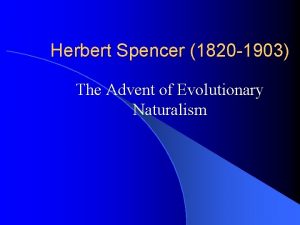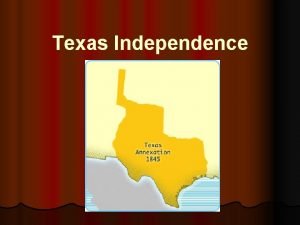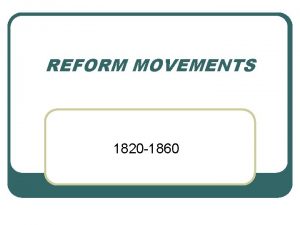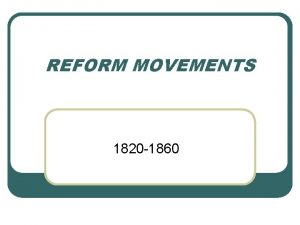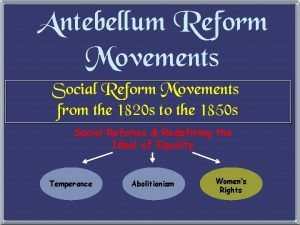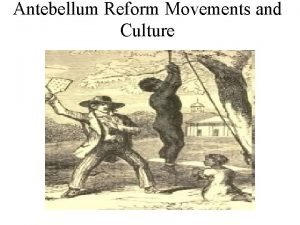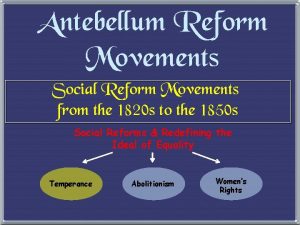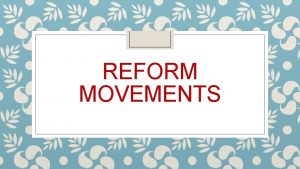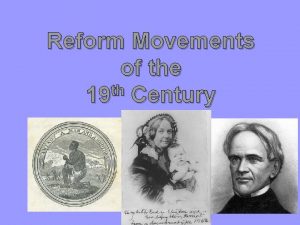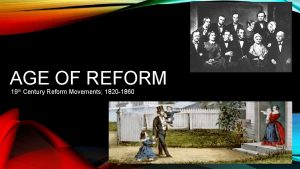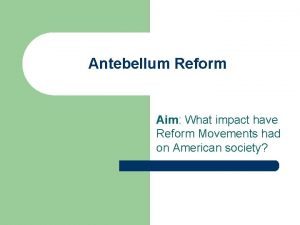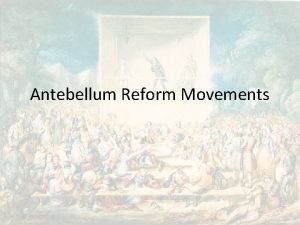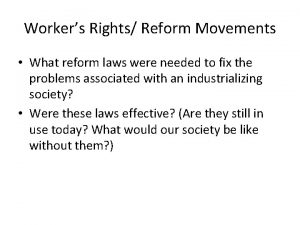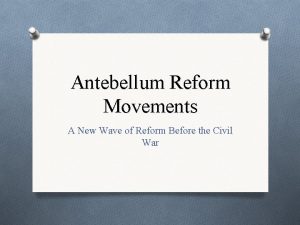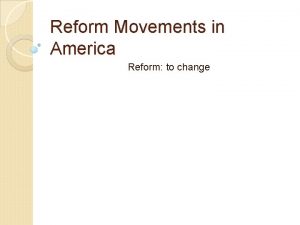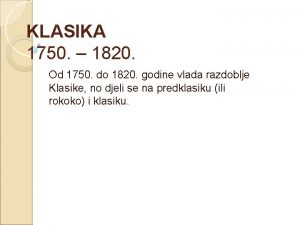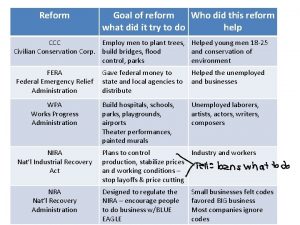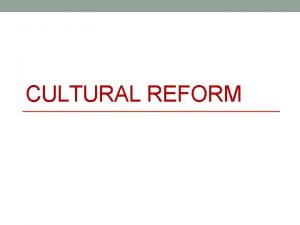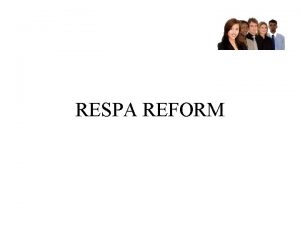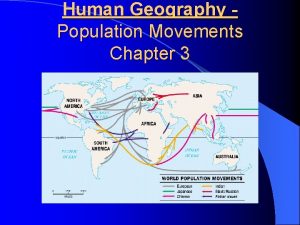Reform Movements of the th 19 Century 1820






![Results and Effects [New Religions] Shakers, Mormons, Baptist, Methodist, Protestant Dems. Soared [Utopias] Also Results and Effects [New Religions] Shakers, Mormons, Baptist, Methodist, Protestant Dems. Soared [Utopias] Also](https://slidetodoc.com/presentation_image/1394f75cd517650c528e421633ce413e/image-7.jpg)

































- Slides: 40

Reform Movements of the th 19 Century (1820 -1860)

1. The Second Great Awakening • Why it emerged? - A reaction to the Enlightenment’s belief in scientific reason over faith and to overall decline in church attendance • People turned to religion for direction with the rapid social and economic changes • Period of religious revivalism • Emotional, entertaining evangelists spread religious fervor in countryside – “Hellfire and brimstone sermons” – burned over district



Important People • Charles Finney – “ Sinners” could achieve moral perfection, eternal salvation, better themselves and their nation – (20, 000 people at a time) • French visitor Alexis de Tocqueville noted how a renewed interest in religious faith in the country • African Americans and women EXTREMELY active • Richard Allen – Philadelphia one of 1 st AA churches in NA

“The Benevolent Empire”: volunteer societies to attack social probs 1825 - 1846 Burned-over: highly prone to religious awakening
![Results and Effects New Religions Shakers Mormons Baptist Methodist Protestant Dems Soared Utopias Also Results and Effects [New Religions] Shakers, Mormons, Baptist, Methodist, Protestant Dems. Soared [Utopias] Also](https://slidetodoc.com/presentation_image/1394f75cd517650c528e421633ce413e/image-7.jpg)
Results and Effects [New Religions] Shakers, Mormons, Baptist, Methodist, Protestant Dems. Soared [Utopias] Also led to moral and social reforms Revivalism in the South? Women’s Temperance Rights Education Asylum & & Penal Reform Abolitionism

2. Utopian Communities

Utopian Societies e Experimental Communities of Perfect, Idealistic societies e. Can be religious or secular e. Over 90 communities between 1800 -1850 John Humphrey Noyes “The Oneida Community, NY 1848) • Communalism • religious • equality • agrarian societies

The Shakers • Believers in Christ’s Second Appearing • Late 1700 s, in New England area – 1 st Utopian society – Life of perfection free of sin – Personal communication with god • Mother Ann (Ann Lee), the messiah • Believed in dualism of God • Known for sexual equality • Simple life, Separate but equal roles for men and women • Declined in 1860 s --- virtually non-existent by 20 th century

The Mormons The Church of Jesus Christ of Latter-Day Saints • Founder, Joseph Smith • Emphasized hard work and community • Emphasis on the structure of family • Highly organized, almost militarized social structure • did not embrace doctrine of individual liberty like others • Controversy of polygamy • Brigham Young - Salt Lake City, Utah

3. Transcendentalism (European Romanticism) e People can transcend, rise above material things in life to reach higher level of intellect e Did not need organized religion to do this e Approach perfection when you acquire knowledge about God, themselves, and universe

Transcendentalist Intellectuals/Writers Concord, MA Ralph Waldo Emerson Nature (1832) Self-Reliance (1841) Inspiration from God through personal unification with nature Henry David Thoreau Walden (1854) Resistance to Civil Disobedience (1849) Part of Anti-slavery movement R 3 -1/3/4/5

Transcendentalist Artists The Hudson River School

In Nature’s Wonderland Thomas Doughty, 1835

4. Temperance Movement 1826 - American Temperance Society “Demon Rum”! The Beecher Family Corrupts family, disobeys god, Poverty, family violence, Criminal activity Carrie A. Nation 1890’s Francis Willard (Leader of WCTU) 1879 1830 s, Americans drank average of 7 gallons of Alcohol person per year

“The Drunkard’s Progress” FROM THE FIRST GLASS TO THE GRAVE. STEP 1. A glass with a friend. STEP 2. A glass to keep the bold chat. STEP 3. A glass too much. STEP 4. Drunk and riotous. STEP 5. The. . companions. A partly mad drunkard. STEP 6. Poverty and disease. STEP 7. Forsaken by friends. STEP 8. Desperation and crime. STEP 9. Death by suicide. From the first glass to the grave, 1846 Prohibition – Maine in 1846

Annual Consumption of Alcohol Reactions by Immigrants -Attack on their culture, customs -Germans, Irish Results, Effects -States begin to limit alcohol by 1. strictly license taverns 2. Adopt liquor taxes -1846 Maine 1 st state to outlaw alcohol - Mid 1800 s, consumption drops significantly -1920, 18 th Prohibition Am.

Education Reform Initial Purpose of schools: Religious Training A New Secular Education: basic curriculum: reading, writing, math Purpose of Education reform: 1. Belief in the innate capacity of every person and society’s obligation to foster that 2. Create a literate, disciplined, respectful work force 3. Create an education system that is more uniform throughout country 4. Tax-supported by state 5. Training programs for better teachers

Horace Mann (1796 -1859) “Father of America Public Education” 1 st Secretary of Board of Ed in MA - 1837 e“great equalizer”, reduce poverty, crime, etc e. Education will improve democratic society, morals and heal social divisions e. He united local school districts into 1 st state taxed system e He called for raising teacher’s salaries, BUT established state teacher training programs e increased school year (6 mon. ) e 1821 1 st free public normal high school in Boston

Effects of the Education Reform • • • Other states quickly followed MA Built new schools, more diverse curriculum created teacher’s colleges and training programs for teachers Offered education to greater groups of children than ever before In some areas teachers better trained than others By Civil War, US had one of highest literacy rates – every state offered public education to white children. • Led to state funded/federal funded universal education in USA • Little Impact in South and West • In west, population was dispersed, hard to have any schools • Entire black pop barred from formal education • 1/3 of white children enrolled in schools in 1860 (vs. 72% in North)

6. Mentally Ill and Penitentiary Reform Dorothea Dix (1802 -1887) Mental ill were kept “in cages, closets, cellars, chained, naked, beaten, lashed into obedience” • Deeply religious teacher, abused as a child • became interested in 1841 -horrible conditions women faced in MA institutions • spent 18 months visiting jails, institutions and reported on it • Result: Separate institutions in which people with mental illness would be treated humanely • @ 24 mental hospitals built b/w 1865 R 1 -5/7 -1880

Prison Reform • Prior to 1800 s: mostly corporal, physical punishments, fines, no rehabilitation • Reformers thought lawbreakers could be reformed – Penitentiary system was created: cultivate penitence – 1821 first penitentiary founded in Auburn, NY, 1829 Eastern State Penitentiary – PA) • 1820’s – NE prison reformer Josiah Quincy – established different places for juvenile correction

7. Abolitionist Movement e Southerners called slavery a “peculiar institution” – part of their lifestyle, their economy e By early 1800 s most northern states had abolished slavery, hoped to end slavery in entire country e 1816 American Colonization Society created (gradual, voluntary emancipation and then send freed AA to Africa, Monrovia (modern day Liberia)

Abolitionist Movement Gradualists Immediatists • By 1830, it was clear that colonization was not very popular • Abolitionists began to turn to more bold campaign for complete end of slavery • David Walker’s, The Appeal, --argueably most radical of all anti-slavery documents “slaves, revolt against your masters with violent action” “America is our country, we have enriched it with our blood and tears”

William Lloyd Garrison – New England Journalist (1801 -1879) e Slavery undermined republican values. e Immediate emancipation, attacked racial prejudice e Slavery was a sin, crime contradicted both Bible and D of I e Slavery was a moral, not an economic issue. R 2 -4

Premiere issue – Jan. 1, 1831 “ I will be as harsh as truth, and as uncompromising as justice. On this subject I do not wish to think, speak, or write with moderation…I am in earnest – I will Not equivocate, I will not excuse, I will not retreat a single inch ---And I will Be heard. 1833 American Anti-Slavery Society is formed – 1 st Nat’l anti-slavery organization R 2 -5

Voices of the American Anti. Slavery Society (1833) Frederick Douglass (1817 -1895) 1845 The Narrative of the Life Of Frederick Douglass “I have suffered under the lash without power to resist” 1847 “The North Star” – anti-slavery R 2 -12 newspaper

Sojourner Truth (1787 -1883) 1850 The Narrative of Sojourner Truth “Ain’t I a woman” R 2 -10

Harriet Tubman (1820 -1913) e. Helped over 300 slaves to freedom. e$40, 000 bounty on her head. e. Served as a Union spy during the Civil War. e. Never lost a single passenger “Moses”

The Underground Railroad

The Underground Railroad e“Conductor” ==== leader of the escape e“Passengers” ==== escaping slaves e“Tracks” ==== routes e“Trains” ==== farm wagons transporting the escaping slaves e“Depots” ==== safe houses to rest/sleep

8. Women’s Rights § 1840 split in the abolitionist movement over women’s role in it. §Garrison call for equal rights §Catherine Beecher - women’s place was in domestic sphere §“Cult of domesticity” – role is to civilize husband family

Early 19 c Women 1. Unable to vote. 2. Legal status of a minor. 3. Single could own her own property. 4. Married no control over her property or her children. 5. Could not initiate divorce. 6. Couldn’t make wills, sign a contract, or bring suit in court without her husband’s permission.

What It Would Be Like If Ladies Had Their Own Way! R 2 -8

Cult of Domesticity = Slavery The 2 nd Great Awakening inspired women to improve society. Angelina Grimké Sarah Grimké e Combined fight for Abolition and Women’s Rights e 1 st women to speak on behalf of American Anti-slavery society Lucy Stone e American Women’s Suffrage Assoc. e Powerful orator, suffered violent insults at lectures she gave e Challenged institution of marriage

London- World Anti-Slavery Convention Lucretia Mott Elizabeth Cady Stanton 1848 Seneca Falls Declaration of Sentiments Susan B. Anthony Nat’l American Women’s Suffrage Assoc. -

Seneca Falls Convention • • 1 st American meeting on women’s rights 300 men and women Signed Declaration of Sentiments Reforms included: – Right to control property for married women – Custody of children upon divorce – Right to education and college – Right to Vote – most fiercely debated issue

Suffrage Amendment • NAWSA had minimal success in first few years of lobbying • By 1901, only 4 states (all located in western area) had given women full voting rights • WWI women lent strong support to war effort – patriotism helped weaken opposition to suffrage • 1920 – the 19 th Amendment was ratified

Nativist Movement • Feared the growing foreign born population migrating to America • Reasons include sheer racism, fear of losing work, corruption of politics • Purpose was to slow immigration • Order of the Star-Spangled Banner, aka, “The Know Nothing Party” • Banning foreigners for holding office • More restrictive naturalization laws • Literacy tests for voting • American Party formed • Results/Effects: not really successful, but this idea continued to exist and influence America in certain decades more so than others • • • Chinese Exclusion Act 1882 National Origins Act 1924 KKK organization
 American reform movements between 1820 and 1860
American reform movements between 1820 and 1860 Reform movements 1800s
Reform movements 1800s Antebellum reform movements apush
Antebellum reform movements apush Reform movements def
Reform movements def What are the example of axial movement
What are the example of axial movement Revolucion liberal de 1820
Revolucion liberal de 1820 Hans oersted 1820
Hans oersted 1820 La campaña definitiva 1820 a 1822
La campaña definitiva 1820 a 1822 El triunfo realista (1812-1820)
El triunfo realista (1812-1820) Music of classical period 1750 to 1820
Music of classical period 1750 to 1820 1820-1900
1820-1900 Florence nightingale was born in 1820 to a rich family
Florence nightingale was born in 1820 to a rich family Apush 1820 to 1860
Apush 1820 to 1860 1820-1900
1820-1900 Florence nightingale, 1820–1910
Florence nightingale, 1820–1910 Revolucion liberal de 1820
Revolucion liberal de 1820 It is an era from 1750-1820
It is an era from 1750-1820 1820 hairstyles
1820 hairstyles 1820-1750
1820-1750 Ryöstö seraljista juoni
Ryöstö seraljista juoni 1820 to 1910
1820 to 1910 Bach classical period
Bach classical period Ccc 1808
Ccc 1808 Classical period characteristics
Classical period characteristics It is an era from 1750-1820
It is an era from 1750-1820 1820-1750
1820-1750 Militarisml
Militarisml Music of the classical period (1750 to 1820)
Music of the classical period (1750 to 1820) Revolucion 1820
Revolucion 1820 Texas 1820
Texas 1820 Cái miệng nó xinh thế
Cái miệng nó xinh thế Các châu lục và đại dương trên thế giới
Các châu lục và đại dương trên thế giới Bổ thể
Bổ thể Từ ngữ thể hiện lòng nhân hậu
Từ ngữ thể hiện lòng nhân hậu Tư thế ngồi viết
Tư thế ngồi viết V. c c
V. c c Thơ thất ngôn tứ tuyệt đường luật
Thơ thất ngôn tứ tuyệt đường luật Phép trừ bù
Phép trừ bù Chúa yêu trần thế alleluia
Chúa yêu trần thế alleluia Hươu thường đẻ mỗi lứa mấy con
Hươu thường đẻ mỗi lứa mấy con Diễn thế sinh thái là
Diễn thế sinh thái là
